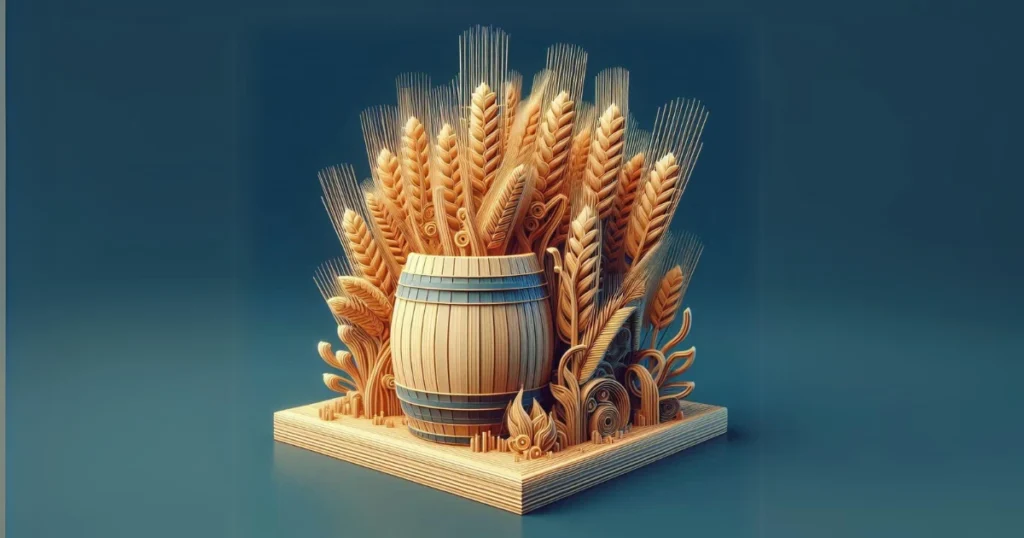
For food, barley is a grain that has a chewy texture and a mild, nutty taste.
It’s the seed of a type of grass that grows in mild climates around the world. Ancient people were also the first to cultivate this grain.
In fact, evidence from archeology shows that Egypt grew barley more than 10,000 years ago.
It grows wild in parts of western Asia and northeast Africa, but it is also widely grown for food for people and animals, as well as to make beer and whiskey.
The world grew 144 million tons of barley in 2014. It is the fourth most common food, after corn, rice, and wheat.
This piece talks about how to add barley to your diet and why it’s good for you.
Healthy Whole Grain
Hulled barley is still whole grain because only the tough top shell was taken off during processing. Pearled barley, which is easier to find, is not a whole grain because the fiber-filled bran has been removed. You can still get some nutrients from pearled barley, but hulled barley is better for you.
Chronic diseases are less likely to happen if you eat a lot of whole grains, chronic diseases are less likely.
A big study with more than 360,000 people found that people who ate the most whole grains, like barley, had a 17% lower chance of death from all causes, like cancer and diabetes, than people who ate the least whole grains.
Other studies have found that eating whole grains may make you less likely to get type 2 diabetes and be overweight.
It’s possible that the health benefits of whole-grain barley come from both its fiber content and its phytonutrients, which are plant substances that are good for you.
Rich in nutrients
Whole grains, like barley, are full of good things for you. It gets twice as big when it cooks, so keep that in mind when you read the nutrition facts.
Half a cup (100 grams) of fresh, hulled barley contains the following nutrients:
- Calories: 354
- Carbs: 73.5 grams
- Fiber: 17.3 grams
- Protein: 12.5 grams
- Fat: 2.3 grams
- Thiamine: 43% of the Reference Daily Intake (RDI)
- Riboflavin: 17% of the RDI
- Niacin: 23% of the RDI
- Vitamin B6: 16% of the RDI
- Folate: 5% of the RDI
- Iron: 20% of the RDI
- Magnesium: 33% of the RDI
- Phosphorus: 26% of the RDI
- Potassium: 13% of the RDI
- Zinc: 18% of the RDI
- Copper: 25% of the RDI
- Manganese: 97% of the RDI
- Selenium: 54% of the RDI
Beta-glucan is the main type of fiber in barley. It is a soluble fiber that gels when mixed with water. Beta-glucan, which is also found in oats, might help lower cholesterol and make it easier to keep blood sugar in check.
Also, antioxidants like vitamin E, beta-carotene, lutein, and zeaxanthin are found in barley. These help protect cells from oxidative stress and fix cell damage that it causes.
Health Benefits
Control blood sugar
Barley may help lower insulin and blood sugar levels, lowering your risk of developing diabetes.
Whole-grain barley contains a lot of fiber, including the soluble fiber beta-glucan. This fiber slows down the absorption of sugar by binding to it in the digestive system.
Ten overweight women who consumed either barley or oats with glucose participated in the study. Both oats and barley have a lower insulin and blood sugar levels. But barley was much better than oats. It reduced levels by 59–65%, whereas oats only reduced them by 29–36%.
One more study looked at 10 healthy men. Those who ate barley for dinner had 30% better insulin sensitivity after breakfast the next morning than those who ate refined wheat bread for dinner.
A review of 232 scientific studies also found a link between eating whole-grain breakfast cereals, such as cereals with barley, and a lower chance of getting diabetes.
A study of 17 overweight women who were more likely to have insulin resistance found that a breakfast cereal with 10 grams of beta-glucan from barley lowered blood sugar levels after a meal more than other types of cereal.
The glycemic index (GI) of barley is also low. The GI shows how quickly a food boosts blood sugar. Barley, with a score of 28, has the lowest score of all the grains.
Improve Digestion
Raw hulled barley, which is half a cup (100 grams), contains 17.3 grams of fiber, or 69% of the RDI for women and 46% of the RDI for men.
Fiber in your diet makes your stools bulkier, making them easier to move through your digestive system.
Barley might assist people who have trouble going to the bathroom. In a study of 16 people with chronic constipation, taking 9 grams of a sprouted barley supplement every day for 10 days and then twice that amount for 10 days improved both the number and size of bowel movements.
Studies have also demonstrated that barley can improve the symptoms of ulcerative colitis, an inflammatory gut disease. Twenty-one people with mild ulcerative colitis felt better after taking 20–30 grams of a sprouted barley supplement over the course of six months.
It’s also possible that barley can help good bacteria grow in your digestive system. Barley’s beta-glucan fiber may help feed good bacteria in the gut, which may make them more probiotic.
A study of 28 healthy people over four weeks found that eating 60 grams of barley a day increased a good type of bacteria in the gut. This bacteria may help lower inflammation and improve blood sugar balance.
Weight management
Fiber-rich foods add bulk to your diet without adding calories because your body can’t break them down. This means that foods high in fiber can help people who are trying to lose weight.
A look at 10 studies on whole grains showed that some grains, like barley, rye, and oats, made people feel fuller after a meal, but whole-grain corn and wheat did not.
Two studies found that people who ate barley for breakfast were less hungry at lunch and ate less at later meals than people who ate rice or whole wheat for breakfast.
This study examined rats fed a high-beta-glucan barley variety. The rats, fed barley with less beta-glucan fiber, consumed 19% less. The animals that ate the wheat with more beta-glucan also lost weight.
Barley may alter hunger and fullness by lowering ghrelin levels. Ghrelin is a hormone that triggers feelings of hunger
Reduce cholesterol
Several studies have found that eating barley may be good for your blood.
Studies have shown that eating a lot of soluble fiber, which barley contains, can reduce overall cholesterol and “bad” LDL cholesterol by 5 to 10%.
A five-week study with 18 men who had high cholesterol found that a meal with 20% of calories from barley lowered their total cholesterol by 20%, lowered their “bad” LDL cholesterol by 24%, and raised their “good” HDL cholesterol by 18%.
In a different study, 44 men with high cholesterol who ate a mix of rice and pearled barley had lower “bad” LDL cholesterol and less belly fat than a control group that ate rice alone.
Drawback
Adding whole grains to your diet is usually a good idea. But some people might not want to eat barley.
To begin, it’s a whole grain that has gluten, just like wheat and rye. Because of this, people with celiac disease or other wheat intolerances shouldn’t eat it.
Barley also contains fructans, which are short-chain carbohydrates that bacteria can break down. Bloating and gas may happen to people with irritable bowel syndrome (IBS) or other stomach problems when they eat fructans.
So, you might want to stay away from barley if you have IBS or a sensitive digestive system.
Finally, barley has a significant effect on blood sugar, so if you have diabetes and are taking insulin or medicines that lower blood sugar, you may want to be careful when you eat it.
Adding Barley to Your Diet
There aren’t many people in the US who eat barley cereal, but it’s easy to add to your day.
There are several varieties of barley, including:
- HULLED barley: This is whole-grain barley that only has the upper, not-edible hull taken off. Other types of barley are chewier, and this one takes longer to cook.
- Pearl barley: After partially steaming, this type of barley removes its hull and bran. More nutrients are in hulled barley, but pearl barley cooks faster.
- Barley flakes: Similar to rolled oats, barley flakes undergo flattening and cutting. They cook quickly, but they don’t have as many ingredients as hulled barley.
- Barley grits: We use toasty and cracked barley to make barley grits. The nutrients they contain depend on where they come from (hulled or pearled barley).
You can substitute hulled barley for other whole grains like rice, quinoa, oats, or buckwheat when cooking.
Before cooking barley, wash the grains under cold, running water to get rid of any hulls. Then cook it with a 1:3 mixture of barley and water. For example, use 1.5 cups of water for every 0.5 cups of barley.
It takes about an hour for pearled barley to cook, but about 1.5 hours for hulled barley to get soft.
There are several ways to prepare barley for eating:
- Instead of oatmeal, try barley flakes for breakfast.
- Put it in stews and soups.
- When you bake, mix barley flour with wheat flour.
- Instead of rice or quinoa, eat it as a side dish.You could drink wheat water.
- Cook barley, then add veggies and dressing to make a grain salad.
The bottom line
Barley has a lot of fiber, especially beta-glucan, which may help lower blood sugar and cholesterol. It might also help you lose weight and process food better.
Refined, pearled barley is less healthy than whole-grain, hulled barley. You can easily incorporate it into your diet and substitute it with any other whole grain.


